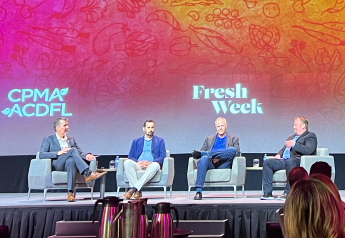Ag water proposed rule draws industry focus, draws some pushback

With final comments due by early April, the Food and Drug Administration's agricultural water proposed rule is drawing much industry attention, said Jennifer McEntire, chief food safety and regulatory officer for the International Fresh Produce Association.
According to a summary of the rule on regulations.gov, the FDA is proposing to amend the agricultural water provisions of the produce safety regulation that covered farms have found complex and challenging to implement.
“This proposal would replace the microbial criteria and testing requirements for preharvest agricultural water for covered produce (other than sprouts), with provisions for systems-based agricultural water assessments that are designed to be more feasible to implement across the wide variety of agricultural water systems, uses and practices, while also being adaptable to future advancements in agricultural water quality science and achieving improved public health protections,” the summary said. Additionally, the FDA said the agency is proposing to require expedited mitigation for hazards related to certain activities associated with adjacent and nearby lands, in light of findings from several recent produce outbreak investigations.
“These proposed revisions to the produce safety regulation, if finalized, would more comprehensively address a known route of microbial contamination that can lead to preventable foodborne illness that is a significant public health problem,” the summary said.
McEntire said in December 2021 that the IFPA has a member group that is looking at the rule for the purposes of offering comment, both in public meetings and at regulations.gov, for the April 5 comment deadline.
McEntire said the risk-based approach the FDA took with the proposed rule is generally one that the industry is supportive of, rather than only leaning on testing results. At the same time, McEntire said the expectations the FDA proposes with its risk-based approach are pretty comprehensive in terms of all the things that growers need to assess and document.
A big priority now, she said, is making sure growers understand those expectations in the proposed rule.
One comment from an anonymous `grower in regulations.gov said the FDA’s new approach leaves a lot of room for interpretation and could be very challenging for mid-sized growers.
In the comment, the grower said they thought the new requirements "will be very confusing and burdensome to many growers. Many have already implemented the water testing protocol that was established under the previous proposed rule. The new rule will be more time-consuming, and farmers are already short on time. I also feel that the FDA will not have the guidance in place prior to the rule being finalized, and we will not know what is fully involved until after the fact to obtain compliance. In addition, famers change what commodities they grow frequently, and having them do a risk assessment after each change in commodity will not happen. Farmers hate doing paperwork and this new proposal will dump a lot of additional paperwork on each farmer.”
In addition, the grower said they believed that the FDA did not have the science to back up the new proposed rule.
“All we keep hearing is how this rule is science-based, but now the science has done a complete 180,” the grower said. “The FDA will lose face in this and, by default, the entire [Food Safety Modernization Act's] produce safety rule will lose face with how dramatic this change is.”
The commenter also expressed concern with how the word "adjacent" would be defined in the proposed rule.
“One farmer could have a small cattle operation adjacent to a fresh produce farm and have to take more action than another fresh produce farm with a huge [concentrated animal feeding operation] two properties away," the grower said. "I also do not know of a farm water source without animal pressures in my area, and mediation steps will need to be taken by the way the new proposed rule is written. My concern is that water testing is not a mediation step, and it seems like you are forcing farmers to either use a municipal water source or start treating water used for irrigation. I just don't understand how the previous [requirement] was 100% based on water testing, but now that is not an option. I feel this rule would put many small- to medium-sized farms in peril if they are using a surface water source.”







